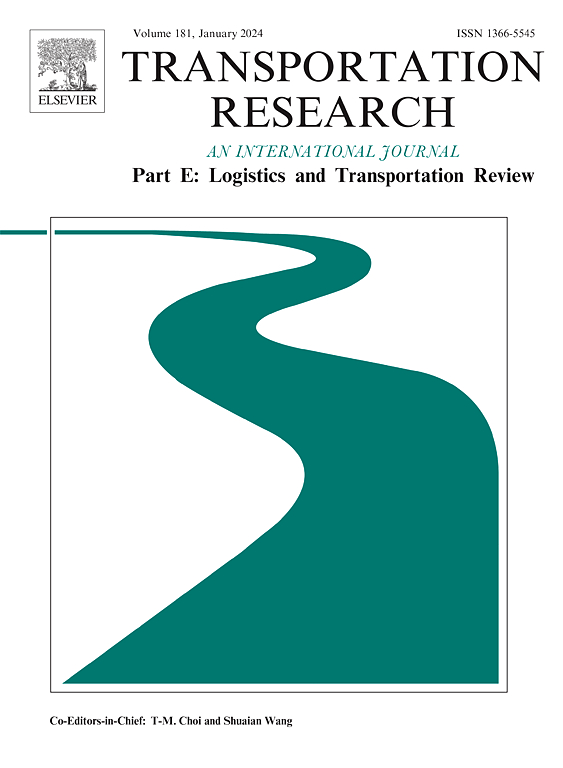Pricing policy and queue-length disclosure in on-demand service platforms
IF 8.8
1区 工程技术
Q1 ECONOMICS
Transportation Research Part E-Logistics and Transportation Review
Pub Date : 2025-10-04
DOI:10.1016/j.tre.2025.104422
引用次数: 0
Abstract
Online service platforms, such as ride-hailing and freight exchanges, generate revenue and profits through commissions. To attract users and maximize profit while managing platform costs, these platforms strategically implement different pricing and queue-length disclosure policies. Dynamic pricing based on queue length can increase revenue but may also reduce user loyalty, leading to higher platform costs. The choice of queue-length disclosure policy influences customer balking behavior: revealing queue lengths may deter users from joining if they perceive the wait as too long, while not disclosing the queue length leads customers to decide probabilistically, driven by uncertainty about the wait time. We analyze a two-sided queueing model in which both customers and suppliers arrive randomly, queue separately, and engage in immediate matching at the front of the queue. We examine different pricing and queue-length disclosure policies to maximize the platform’s expected profit. Optimizing the underlying semi-Markov decision process requires solving a non-convex quadratically constrained quadratic program. Through uniformization, we derive and solve the optimality equations, and then compare the resulting optimal prices, profits, and throughput. Our findings indicate that pricing and queue-length disclosure policies are complementary. Specifically, dynamic pricing and visible queue lengths both increase expected profit, while static pricing and invisible queue lengths both increase throughput. These outcomes are driven by changes in the average transaction price under different policies. We identify unique thresholds that determine the preferred pricing and queue-length disclosure policies. The choice of pricing policy depends on the extra cost of implementing dynamic pricing compared to a static price, while the selection of queue-length disclosure policy depends on customer sensitivity to service delay.
按需服务平台的定价策略与排队长度披露
在线服务平台,如网约车和货运交易所,通过佣金产生收入和利润。为了在管理平台成本的同时吸引用户并实现利润最大化,这些平台战略性地实施了不同的定价和排队长度披露政策。基于排队长度的动态定价可以增加收益,但也可能降低用户忠诚度,导致更高的平台成本。队列长度披露策略的选择会影响客户的犹豫行为:如果用户认为等待时间太长,披露队列长度可能会阻止他们加入,而不披露队列长度则会导致客户在等待时间的不确定性的驱使下做出概率性决定。本文分析了客户和供应商随机到达、分别排队并在队列前面进行即时匹配的双边排队模型。我们研究了不同的定价和排队长度披露政策,以最大化平台的预期利润。优化底层的半马尔可夫决策过程需要求解一个非凸二次约束的二次规划。通过统一化,我们推导并求解了最优性方程,然后比较了得到的最优价格、利润和吞吐量。我们的研究结果表明,定价和排队长度披露政策是互补的。具体来说,动态定价和可见队列长度都增加了预期利润,而静态定价和不可见队列长度都增加了吞吐量。这些结果是由不同政策下平均交易价格的变化所驱动的。我们确定了确定首选定价和队列长度披露策略的唯一阈值。定价策略的选择取决于实现动态定价相对于静态定价的额外成本,而队列长度披露策略的选择取决于客户对服务延迟的敏感性。
本文章由计算机程序翻译,如有差异,请以英文原文为准。
求助全文
约1分钟内获得全文
求助全文
来源期刊
CiteScore
16.20
自引率
16.00%
发文量
285
审稿时长
62 days
期刊介绍:
Transportation Research Part E: Logistics and Transportation Review is a reputable journal that publishes high-quality articles covering a wide range of topics in the field of logistics and transportation research. The journal welcomes submissions on various subjects, including transport economics, transport infrastructure and investment appraisal, evaluation of public policies related to transportation, empirical and analytical studies of logistics management practices and performance, logistics and operations models, and logistics and supply chain management.
Part E aims to provide informative and well-researched articles that contribute to the understanding and advancement of the field. The content of the journal is complementary to other prestigious journals in transportation research, such as Transportation Research Part A: Policy and Practice, Part B: Methodological, Part C: Emerging Technologies, Part D: Transport and Environment, and Part F: Traffic Psychology and Behaviour. Together, these journals form a comprehensive and cohesive reference for current research in transportation science.

 求助内容:
求助内容: 应助结果提醒方式:
应助结果提醒方式:


